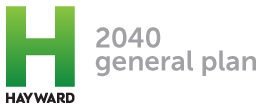Mixed-Use Development
The density and intensity of mixed-use developments that include both commercial and residential uses are regulated by both the maximum residential density (units per acre) and the maximum FAR standard for the land use designation. As an example, a one acre site (43,560 sq. ft.) with a maximum FAR of 1.0 and an allowed density range of 17.5 to 35 units per acre could be developed with 43,560 square feet of total building space. The 43,560 square feet could be divided into a combination of commercial space and residential space. Up to 35 units would be allowed within the 43,560 square feet.
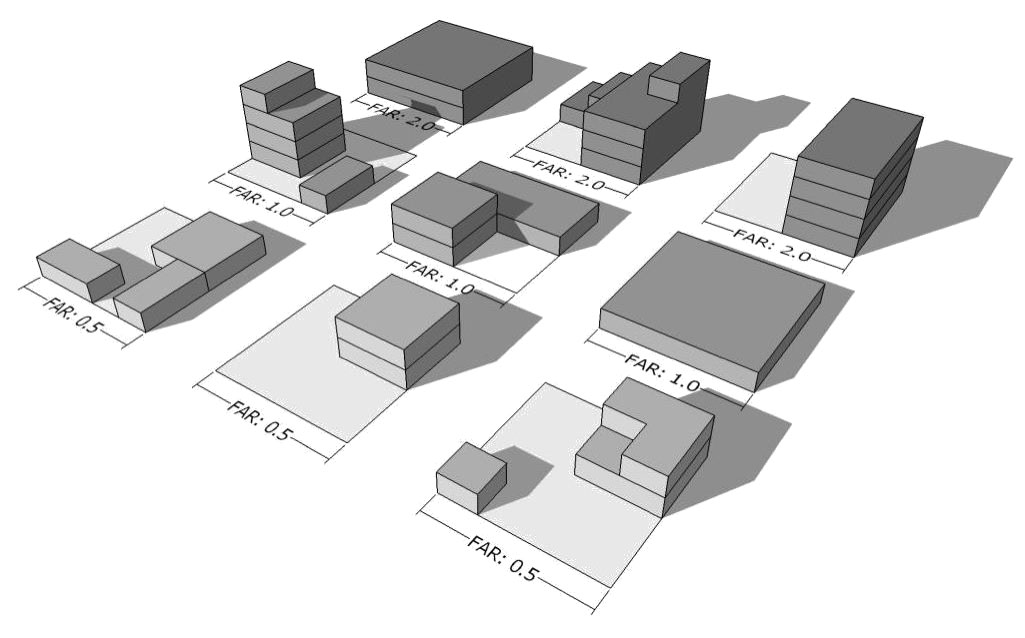
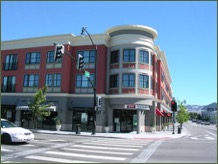 The Commercial/High-Density Residential designation generally applies to commercial and residential properties located along arterial streets. Typical building types include townhomes, live-work units, multi-story apartment and condominium buildings, commercial buildings, shopping centers, and mixed-use buildings that contain commercial uses on the ground floor and residential units or office space on upper floors. Future changes to Commercial/High-Density Residential areas are expected to include building and landscaping improvements; the rehabilitation or redevelopment of underutilized properties; additional commercial, residential, and mixed-use development; and other enhancements that create more pedestrian-oriented commercial centers and multi-modal corridors.
The Commercial/High-Density Residential designation generally applies to commercial and residential properties located along arterial streets. Typical building types include townhomes, live-work units, multi-story apartment and condominium buildings, commercial buildings, shopping centers, and mixed-use buildings that contain commercial uses on the ground floor and residential units or office space on upper floors. Future changes to Commercial/High-Density Residential areas are expected to include building and landscaping improvements; the rehabilitation or redevelopment of underutilized properties; additional commercial, residential, and mixed-use development; and other enhancements that create more pedestrian-oriented commercial centers and multi-modal corridors.
Allowed Uses
- Retail, dining, and service uses
- Professional office uses
- Mixed-use with multi-family homes or office on upper floors
- Attached single-family homes
- Multi-family homes
- Live-work units
Supporting Uses
- Lodging
- Entertainment and recreational uses
- Automobile service and repair stations
- Parks, recreation facilities, open space, and trails
- Community gardens
- Compatible public and quasi-public uses
- Religious and cultural facilities
Development Standards
- Maximum FAR: 0.8
- Density (only applies to mixed-use and residential projects): A maximum of 34.8 dwelling unit per net acre. A minimum density is not required.
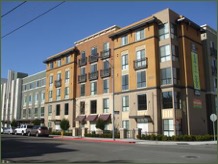 The Sustainable Mixed-Use designation generally applies to areas near regional transit that are planned as walkable urban neighborhoods. Typical building types will vary based on the zoning of the property, but will generally include single-family homes, duplexes, triplexes, fourplexes, second units, townhomes, live-work units, multi-story apartment and condominium buildings, commercial buildings, and mixed-use buildings that contain commercial uses on the ground floor and residential units or office space on upper floors. Sustainable Mixed-Use areas are expected to change substantially in the future, as properties are planned to be developed or redeveloped at relatively high densities and intensities to create walkable and mixed-use neighborhoods and multi-modal corridors.
The Sustainable Mixed-Use designation generally applies to areas near regional transit that are planned as walkable urban neighborhoods. Typical building types will vary based on the zoning of the property, but will generally include single-family homes, duplexes, triplexes, fourplexes, second units, townhomes, live-work units, multi-story apartment and condominium buildings, commercial buildings, and mixed-use buildings that contain commercial uses on the ground floor and residential units or office space on upper floors. Sustainable Mixed-Use areas are expected to change substantially in the future, as properties are planned to be developed or redeveloped at relatively high densities and intensities to create walkable and mixed-use neighborhoods and multi-modal corridors.
Allowed Uses
- Retail, dining, and service uses
- Professional office uses
- Detached single-family homes
- Attached single-family homes
- Multi-family homes
- Live-work units
- Mixed-use with multi-family homes or office on upper floors
Supporting Uses
- Second units
- Lodging
- Entertainment and recreational uses
- Automobile service and repair stations
- Parks, recreation facilities, open space, and trails
- Community gardens
- Compatible public and quasi-public uses
- Religious and cultural facilities
- Satellite college campus uses and student housing
Development Standards
- Maximum FAR: 2.0 or 2.75 if located within transit overlay zones established by zoning.
- Density (only applies to mixed-use and residential projects): Minimum and maximum densities vary greatly based on the property’s zoning and proximity to regional transit. Densities range from 4.3 to 100 dwelling units per net acre.
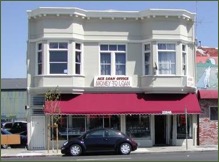 The Central City-Retail and Office Commercial designation generally applies to the core of Downtown Hayward. Typical building types include storefront commercial buildings and mixed-use buildings that contain commercial uses on the ground floor and residential units or office space on upper floors. Other building types that may be appropriate on properties outside of the retail core of the Downtown include townhomes, apartment and condominium buildings, and live-work units. Future changes to Central City-Retail and Office Commercial areas are expected to include the rehabilitation of historic buildings, infill commercial and mixed-use development, building and landscaping improvements, the rehabilitation or redevelopment of underutilized properties, and other district enhancements that help transform the Downtown into a vibrant, transit-oriented, and mixed-use city center.
The Central City-Retail and Office Commercial designation generally applies to the core of Downtown Hayward. Typical building types include storefront commercial buildings and mixed-use buildings that contain commercial uses on the ground floor and residential units or office space on upper floors. Other building types that may be appropriate on properties outside of the retail core of the Downtown include townhomes, apartment and condominium buildings, and live-work units. Future changes to Central City-Retail and Office Commercial areas are expected to include the rehabilitation of historic buildings, infill commercial and mixed-use development, building and landscaping improvements, the rehabilitation or redevelopment of underutilized properties, and other district enhancements that help transform the Downtown into a vibrant, transit-oriented, and mixed-use city center.
Allowed Uses
- Retail, dining, and service uses
- Professional office uses
- Entertainment and recreational uses
- Mixed-use with multi-family homes or office on upper floors
Supporting Uses
- Attached single-family homes
- Multi-family homes
- Live-work units
- Lodging
- Compatible public and quasi-public uses
- Parks, recreation facilities, open space, and trails
- Community Gardens
- Religious and cultural facilities
- Satellite college campus uses and student housing
Development Standards
- Maximum FAR: 1.5
- Density (only applies to mixed-use and residential projects): Maximum densities vary greatly based on the property’s zoning and proximity to regional transit. Maximum densities range from 40 to 110 dwelling units per net acre. Minimum densities are not required.
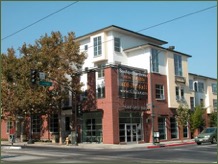 The Central City-High Density Residential designation generally applies to properties surrounding the core of Downtown Hayward. Typical building types include townhomes, live-work units, apartment and condominium buildings, and multi-story mixed-use buildings that contain commercial uses on the ground floor and residential units or office space on upper floors. Future changes to Central City-High Density Residential areas are expected to include the rehabilitation of historic buildings; infill commercial, residential, and mixed-use development; building and landscaping improvements; the rehabilitation or redevelopment of underutilized properties; and other district enhancements that help transform the Downtown into a vibrant, transit-oriented, and mixed-use city center.
The Central City-High Density Residential designation generally applies to properties surrounding the core of Downtown Hayward. Typical building types include townhomes, live-work units, apartment and condominium buildings, and multi-story mixed-use buildings that contain commercial uses on the ground floor and residential units or office space on upper floors. Future changes to Central City-High Density Residential areas are expected to include the rehabilitation of historic buildings; infill commercial, residential, and mixed-use development; building and landscaping improvements; the rehabilitation or redevelopment of underutilized properties; and other district enhancements that help transform the Downtown into a vibrant, transit-oriented, and mixed-use city center.
Allowed Uses
- Retail, dining, and service uses
- Professional office uses
- Mixed-use with multi-family homes or office on upper floors
Supporting Uses
- Entertainment and recreational uses
- Lodging
- Attached single-family homes
- Multi-family homes
- Live-work units
- Compatible public and quasi-public uses
- Parks, recreation facilities, open space, and trails
- Community Gardens
- Religious and cultural facilities
- Satellite college campus uses and student housing
Development Standards
- Maximum FAR: 1.5
- Density (only applies to mixed-use and residential projects): Maximum densities vary greatly based on the property’s zoning and proximity to regional transit. Maximum densities range from 40 to 110 dwelling units per net acre. Minimum densities are not required.
